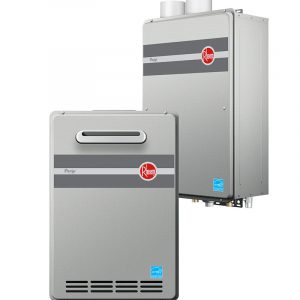 Hot water heaters are behind-the-scenes dynamos in modern homes. Most of us never need to think about them until something goes wrong. (Or the hot water runs out!)
Hot water heaters are behind-the-scenes dynamos in modern homes. Most of us never need to think about them until something goes wrong. (Or the hot water runs out!)
These appliances have been around in one form or another since the 1860s. Edwin Ruud, a Norwegian mechanical engineer and inventor living in Pittsburgh, was influenced by Englishman Benjamin Waddy Maughan’s design for a domestic water heater.
Ruud’s revised and updated water heater set the standard for all that followed. (Ruud’s company is still around, by the way; it’s now a division of Rheem.)
Modern water heaters are gas or electric, tank and tankless.
When the time comes to install an electric water heater, however, you can follow the procedure below, but please note: This broad outline only covers the absolute basics. If you have no experience with this type of plumbing work, or with electrical work, for that matter, then it’s essential that you contact a Portland plumber — Meticulous Plumbing, to be exact!
Water heaters typically last up to 10 or 15 years. If you notice a leak, that’s definitely a sign that your water heater needs maintenance or replacement. Leaks can be repaired unless it’s the tank itself that’s leaking; in that case, you’ll probably need to replace it.
Sometimes the problems are within: Over their operational lifespan, water heaters build up sediment, becoming less efficient in the process.
Contact Meticulous Plumbing with any questions or concerns. We can help you diagnose the problem and, if necessary, install a new electric water heater for you.
First Things First
For the purposes of this overview, we’ll assume you’re interested in installing an electric water heater with a tank. These are the familiar metal cylinders that usually hold between 30 and 80 gallons of water.
Let’s get to it!
But first things first: This is not necessarily easy to do. As the good folks at Popular Mechanics warn: “A water heater, especially an electric model, is a very simple device. … Unfortunately, such simplicity doesn’t really extend to its installation.”
As we mentioned above, we’re gonna try and simplify the overall process, and to sketch it out in broad strokes. This blog post should provide what you might call the 30,000-foot-view — that is to say: an idea of the main steps. If after reading it you decide you want to tackle this project on your own, then we suggest diving into a more comprehensive step-by-step guide at that point.
And so, without further ado …
How To Install: Electric Water Heater (The Basics)
- Familiarize Yourself With The Water Heater. It’s always a good idea to take some time to look over the water heater itself and to read the literature that comes along with it. Perhaps most importantly: the safety warnings that are a major portion of the instruction, installation, and operations manual. Be sure to pay close attention to the manufacturer’s recommendations, especially those related to the water heater’s warranty.
- Cut The Power. At your circuit breaker panel, turn off the electricity to your water heater. It’s absolutely vital that you make sure there is no electricity reaching the water heater. Use a voltage detector to verify. If and only if you have electrical experience, disconnect the electrical wires to the water heater.
- Drain The Old Water Heater Tank. This involves several steps, including procedures to ensure your safety so that you don’t get scalded. Shut off the water heater’s supply valve. (This is the valve that lets water flow into the heater.) Attach a garden hose to the drain valve, and run the hose outside. Open the drain valve and the pressure relief valve. Let the water drain.
- Remove The Old Water Heater. Once the water has emptied from the old water heater, you can begin the process of removing it. You’ll probably need help — and a dolly.
- Put The New Water Heater In Place. Place the new tank in position, making sure that you’ll be able to access the panels and valves for maintenance in the future.
- Reattach Vitals. Now it’s time to reattach piping and electrical wiring.
- Fill Your New Hot Water Heater With Water. Watch for leaks during this process.
- Turn The Power Back On.
Meticulous Plumbing In Portland OR
As we’ve stressed repeatedly in this blog post, installing an electric water heater is not a job for someone who doesn’t have pretty extensive experience with both plumbing and electrical systems.
As the broad outline above suggests, there can be many individual steps involved in each of the eight steps listed above — and more steps involved in each of those smaller steps!
It’s enough to make you want to call in an expert.
Fortunately, a plumbing expert in Portland OR is just a phone call away! Contact Meticulous Plumbing today to have your new electric water heater installed by professionals.
There are several options when it comes to water heaters, and we can help decide which one is best for you. Once you’ve decided, our expert plumbing team can visit your home and install your new water heater.
Call us today to get started!

